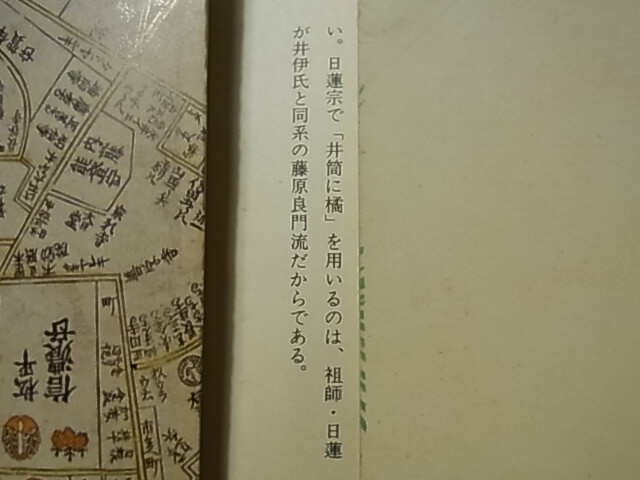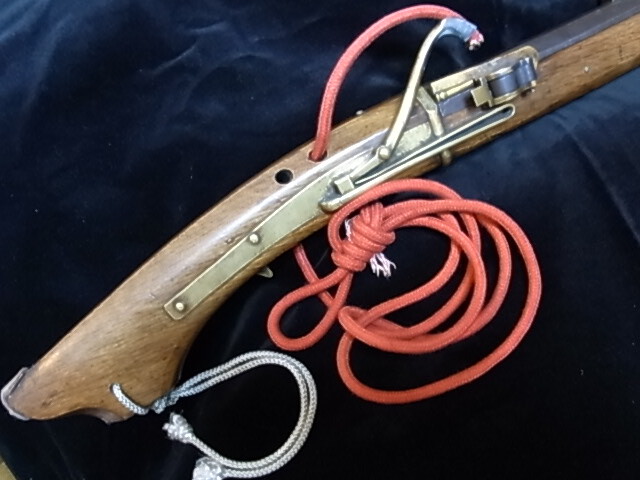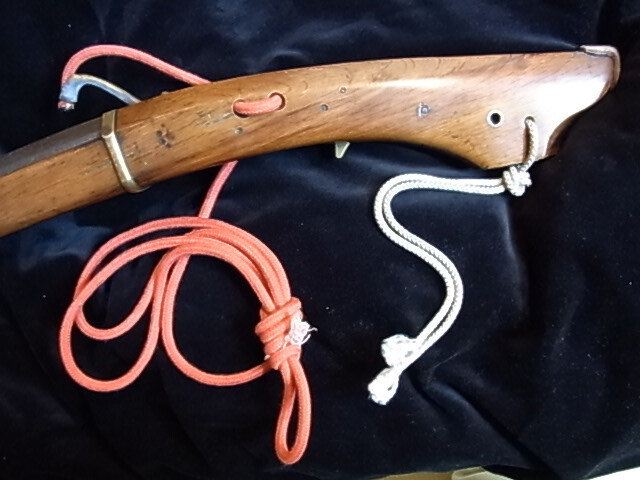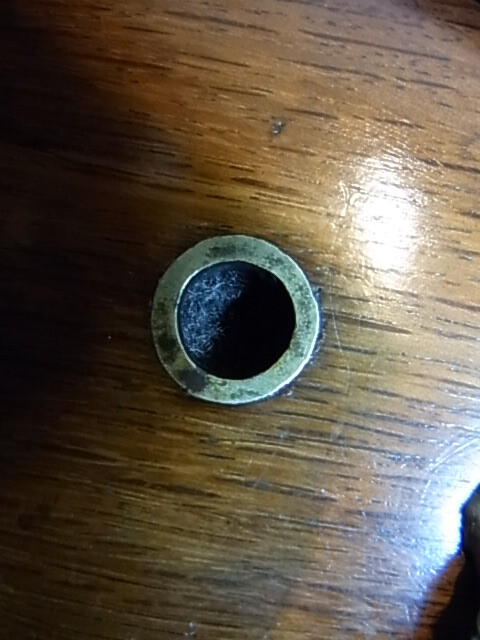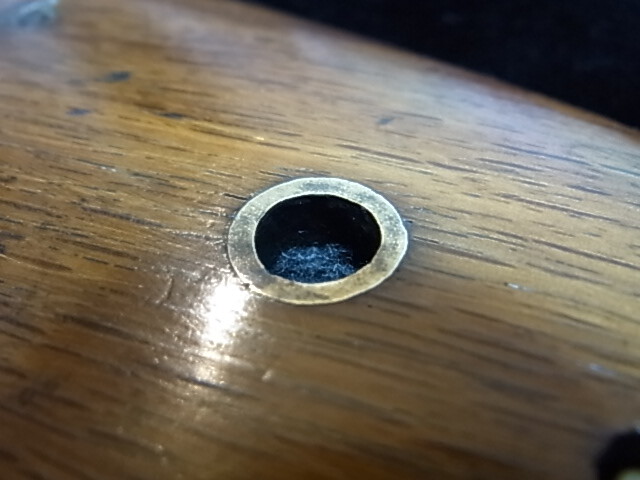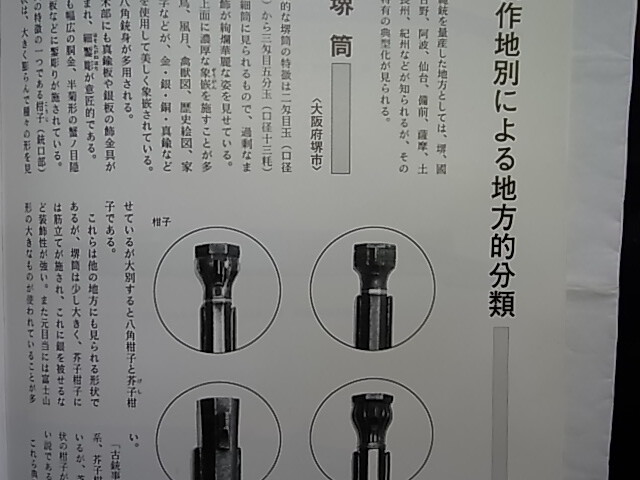-
Posts
14,270 -
Joined
-
Last visited
-
Days Won
275
Content Type
Profiles
Forums
Events
Store
Downloads
Gallery
Everything posted by Bugyotsuji
-
Just for quick clarification. (Thank you for posting your good-looking gun, Ron.) Earlier I suggested that there were even elements of Sendai in it, and gave as an example the hollow loop trigger. Well, today I was shown a pair of special Tokugawa pistols made by the famous Kunitomo Ikkansai, and I was surprised to see that they both had looped triggers. Whether this was a weight-saving feature that gradually became common throughout Japan or not, I do not know, but it is now clearer to me that such Sukashi triggers were certainly not limited to Sendai. As an aside, I also noticed at once that they had snuffer hollows very similar to my late Edo long gun, and quite different to some of those highly-decorated medallion holes that we often associate with Sakai etc. Why these should be on the left side of the gun had me thinking, and if all the logic so far holds up, then I would like to suggest that it is a Japanese psychological thing to separate lighting a fire, and extinguishing a fire, by a wall or barrier. Say you are about to fire, and suddenly the order is rescinded. You would shut the pan, remove your matchcord, and you might be required to turn the 'dangerous' side of the gun away from you, ie downwards, in order to demonstrate to all and sundry a deliberate act of snuffery. Shades of martial arts and judges, & schools of gunnery. (Idle thoughts on a Saturday afternoon.)
-

This Week's Edo Period Corner
Bugyotsuji replied to Bugyotsuji's topic in General Nihonto Related Discussion
Here is the Jingasa from inside. It is not obvious, to me anyway, which was the front and which was the back. Perhaps it was designed to be worn depending on the day and who was leading!!! Just been shown a pair of magnificent matchlock pistols by Kunitomo Ikkansai, the go-between for the Tokugawas and the smiths of Kunitomo. They were once worth 60,000 USD before the bubble. As I will post over on Ron's other thread in a minute, I was surprised to see the triggers were loops, just like his gun, which I had supposed was a feature of Sendai guns. They both had Hi-keshi-ana snuffers very like my long gun, so these pistols must be fairly late Edo, if our logic holds. -

Swordsmith Scroll Translation Help
Bugyotsuji replied to Aloof Pegasus's topic in Translation Assistance
Morita sama, I have no idea how you can do that, but it's a wonderful and rare talent you have and should be taught to more young people! -

Swordsmith Scroll Translation Help
Bugyotsuji replied to Aloof Pegasus's topic in Translation Assistance
Can't read it, but I'm liking the scroll and looking forward to the reading! -

An Interesting 8 Monme Tanegashima
Bugyotsuji replied to watsonmil's topic in Tanegashima / Teppo / Hinawajū
This will be full of holes, but perhaps Koichi san, Morita san or someone can help me. "The reason that Nichiren-shu uses the Izutsu-no-Tachibana is that the founder, Nichiren, was of the same strand/line of Fujiwara Ryomon Ryu as the Lord Ii. (?) -

An Interesting 8 Monme Tanegashima
Bugyotsuji replied to watsonmil's topic in Tanegashima / Teppo / Hinawajū
Just found another Ka-Mon source confirming a link between Nichiren and the ii family. This book, p156 The two last lines of the explanation say: -

This Week's Edo Period Corner
Bugyotsuji replied to Bugyotsuji's topic in General Nihonto Related Discussion
John, it's in my study at work. I'll go back and have a closer look and see if it is obvious, from the bindings, which is the front and which is the back. The person who had it before me several years ago said it was a Teppo-tai (musketeer's) Jingasa. I've always wondered about it. In fact I had sort of imagined it might be from Saigo Takamori's Satsuma Rebellion. -

This Week's Edo Period Corner
Bugyotsuji replied to Bugyotsuji's topic in General Nihonto Related Discussion
Much appreciated, John. Wow, it's complicated isn't it! Now I am looking at this Jingasa in a new light! (It's got very tatty straw bolsters and drawstrings underneath) :lol: -

This Week's Edo Period Corner
Bugyotsuji replied to Bugyotsuji's topic in General Nihonto Related Discussion
Thank you John! Yes, that brings on my next harder question. Who would have had an Omote Mon and an Ura Mon in combination like this? Hoping someone can help, as for sure I do not know. Oh, and thanks to Koichi sama too! PS Kuyo-Mon was used not only by Hosokawa, John, so 'Hosokawa' is not a given, especially if it is an Ura Mon. -

This Week's Edo Period Corner
Bugyotsuji replied to Bugyotsuji's topic in General Nihonto Related Discussion
Eric, the two glass bottles with the two iron sands were one question. The answer is mostly out now. The Jingasa (conical hat) trick has yet to be solved! To repeat, how many hats can you see? :D ("They" look to be in good condition because a) you cannot see the repairs, and b) I polished "them" with some magical gunk...) :lol: -

This Week's Edo Period Corner
Bugyotsuji replied to Bugyotsuji's topic in General Nihonto Related Discussion
Apologies, Eric, my brain has been in an altered state. Hint, you say? How many Jingasa do you see? The two jars: The left one is from the iron sands beach at Tanegashima where the first guns arrived in Japan and the first Japanese guns were made. The right is from iron-rich river sand in Hyogo, not far east of Bizen, from which Nihonto bladed weapons were made. -

This Week's Edo Period Corner
Bugyotsuji replied to Bugyotsuji's topic in General Nihonto Related Discussion
John, you're blazing the way forwards! -

This Week's Edo Period Corner
Bugyotsuji replied to Bugyotsuji's topic in General Nihonto Related Discussion
Ladies & Gents, post your answers! (any hints needed?) -

This Week's Edo Period Corner
Bugyotsuji replied to Bugyotsuji's topic in General Nihonto Related Discussion
While everyone is considering the Ranma (?) and Jingasa above, here is Question 2. I know the answer to this, but think of it as a test of your Japanese Kanji reading ability. If it's easy for you, please hold off until others have tried! Question 2. What is in the glass jars, and how are they the same or different? Some piccies here to give you a hint -

This Week's Edo Period Corner
Bugyotsuji replied to Bugyotsuji's topic in General Nihonto Related Discussion
Many have looked but no-one has answered. A mystery indeed. Originally one of a pair? Part of a ship's decoration? Part of a Ranma as you suggest? Something from a temple or shrine that has been refurbished? Gosh... a nice thing to have, though. While we wait for further comments, I have two contributions this week. Both are questions. Number one is a a combination. I know the answer to part a), but not the answer to b)... 1. a) What do these two Jingasa photos have in common? b) What does the answer in a) tell us? -

Please help! Koshu Tokubetsu Kicho Ninteisho???
Bugyotsuji replied to IchiNi's topic in Translation Assistance
Hi Vlad, it describes the Daisho, and the quick answer to your question is 'Yes', but what else do you want to know? -
Quick question. Why did you write ASAP in the title? :|
-
What a magnificent example of a gwalior. I wonder if the pricker was draped over the barrel between the sight and the (?) panlid handle in some way to stop the lid opening? I always carry a pricker separately in the Doran (beltbox), but there is certainly an attraction to having it attached near the pan.
-
I am beginning to think the same thing, Ron. The medallion cord hole somehow evolved over time through obsolescence, coincidence, necessity etc., into a very useful match snuffer.
-
If I fire an average of 7 shots, perhaps 12 demonstrations a year with this gun, then that means I must have fired it about 600 times since I purchased it. Oh, and apologies for the rather rupturous threadnap, Ron!
-
Ian, if that is a sheath for a pricker, I can imagine it would stay in if the gun was pushed down into a horse's holster, but would it not slide back out when lifted up into the firing position? Thought-provoking pics. Many thanks. Further to the above post, I include some shots of the quite shallow ringed hollow in the butt of my Kumamoto Castle gun. (I think a small bird might have made a nest in there.) You can also see the two parallel match holes and a separate narrower hole for a decorative lanyard.
-
Quick edit above. My Kumamoto gun is dated Koka 4 nen, 1847 (not '1867' as I mistakenly posted earlier. Now edited.) I will post a piccie of the hole in question when I get home, if I can just get this other deskwork out of the way first! Who invented work? The NAMAE site I have just posted above is I believe independent and unrelated to the earlier link to Sugawa san. Yes, I agree that our two previously extreme positions may be moving somewhat together. I have learned a lot in the process of this discussion. Many thanks.
-
Hi Ron, some quick thoughts regarding your points above. 1. Yours are very deep. Mine is shallower. I am beginning to wonder whether the original straight-through hole was under-used and someone tried blocking it with whatever, and then they disovered you could get away with half the hole and half the decorations (= half the labor/labour) during manufacture. This may explain why there is so little literature on this feature, and only later guns seem to have it in this form. 2. From personal observation I agree that it is located in an inconvenient place for me, especially when my hands are full of other clobber. The other side would be better. Our matches are seriously hot however, and even with a large dollop of spit you would have to have very horny hands to avoid getting burnt. You would then have the problem of relighting if such became suddenly necessary. 3.About the angled hole you mention, my long gun has two of these in parallel. These holes would be the ones mentioned in the line above the line quoted, in the description web page. 火縄通しの穴 有無、材質、内径、飾り金具 = matchcord tunnel(s), presence/absence of, material(s) inner diameter, decorative metalwork I have used these in the past to push the matchcord through, though I am not yet convinced that the angle of them points consciously (decoratively perhaps) towards the Hachimanza. 4. Granted, depending on the other factors. 5. My Kumamoto Castle gun, definitely a combat gun, but of late vintage (1847) has this half-hole, but ringed only once in plain but thick brass. The inner end is wood, so I am burning the stock a little more each time I use it! Is that why yours are deeper, thru much use??? 6. OK 7. As you see, I did say that his work is not definitive. Agreed. I don't think anyone has yet had this debate anywhere so I am glad we are having it here.
-
Before I answer your detailed post above Ron, I just want to put this up before I forget it. (Old age) This 'NAMAE' site, based in Kamakura, is a site that lists for descriptive purposes the names for all the parts of the Tanegashima, and in 'The Stock', section 3 from the top, line 16, you can find this line: 火縄消しの穴 火消壷 有無、材質、内径、深さ、飾り金具(段数) = Match extinguish hole, fire extinguish hole, absence/presence of, material(s), inner diameter, depth, decorative metalwork (number of Dan) This comes from the following page. (In Japanese, sorry) http://www.geocities.jp/nosuka02/NAMAE.html
-
Concerning the use of the decorated cavity/half-hole I cannot say that my teacher told me this was for extinguishing the Hinawa. All my instincts and training tell me this has to be the purpose, although I grant that when displaying the gun a short section of match fed into this hole might be a good way to display it. The problem is that it would fall out immediately if you tried to use it like that. Some older guns have a hole that goes straight through, but this shallow hole would mean use of a very short cord, which would make little sense in battle, I am sure you would agree. The cord is always wrapped around the left forearm and gradually fed to the serpentine, through the diagonal hole as you suggest when it is present. When we finish our displays there is always an urgent message flashed around to extinguish our matches. They were precious in olden times I would guess. Some of our members carry a pair of scissors, but I have found the easiest and quickest way to comply is to push it in and suffocate the cord within this close-fitting metal-lined hollow. On p 18 of Sugawa san's pdf he calls this an extinguishing hole, ie Hi-keshi-no-ana 火消しの孔 http://www.mlsa.jp/sugawa/hinawajyu3.pdf This is by no means definitive, but I would like to go away and toss this around a little more and gather a few more grizzled opinions if I may, Ron. PS Here is a further selection of Sakai muzzles. PPS Your gun also has influences of Sendai in it! (The trigger etc.)(Or am I beginning to see things?) :lol:




